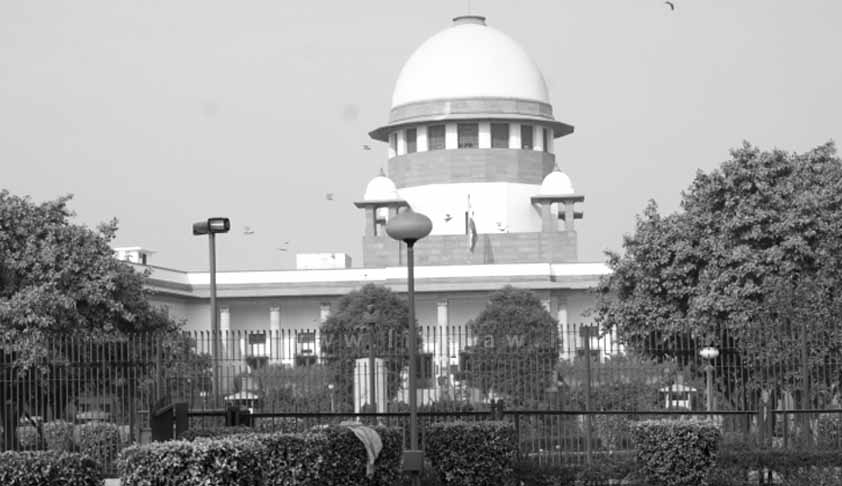Classic Case Of Shrugging Off By Referring To A Larger Bench - Dejusticizing Justice?
Namit Saxena
22 Dec 2016 5:41 AM GMT
A popular joke floating on social media says that a man went to the washroom and by the time he came out, the Government had come up with a new rule or policy concerning Demonetization. A lot of ink has found place in national and international news evaluating the Demonetization move but what is particularly perplexing is how a three judge bench of the Supreme Court has simply shrugged off...
A popular joke floating on social media says that a man went to the washroom and by the time he came out, the Government had come up with a new rule or policy concerning Demonetization. A lot of ink has found place in national and international news evaluating the Demonetization move but what is particularly perplexing is how a three judge bench of the Supreme Court has simply shrugged off the issue.
A three judge bench of the Supreme Court (Supreme Court sits in a minimum quorum of 2 judges and 3 judge bench is considered a larger bench) presided by the Chief Justice of India vide order dated 16.12.2016 in a batch of petitions challenging demonetization referred it to a larger bench and stalled all proceedings before various High Courts. What is amusing is that the Supreme Court observed its last working day of the calendar year from 16th December and closed for 2 weeks only to reopen on 2nd January 2017 with vacation bench of 2 judges (lesser quantum than 3) to sit on the 23rd and 30th of December for Miscellaneous matters.
The history of Supreme Court is filled with instances of two judge benches hearing and deciding constitutional validity of statutory provisions both ways. In two notable examples, a two judge bench of the Supreme Court quashed Section 66A of the IT Act in Shreya Singhal v Union of India and it was a 2 judge bench which decided and upheld constitutional validity of Section 377 of the Indian Penal Code, 1860. Before checking the 9 questions of law referred, let us read the operative part, the 3 judge bench comprising of Justices Khanwilkar and Chandrachud apart from Justice Thakur wrote – “Keeping in view the general public importance and the far reaching implications which the answers to the questions may have, we consider it proper to direct that the matters be placed before the larger bench of five judges for an authoritative pronouncement. The Registry shall accordingly place the papers before Hon’ble the Chief Justice for constituting an appropriate Bench.”
In my view, if the bench understood what ‘general public importance’ and ‘far reaching implications’ actually were it would not have made the reference a mere academic exercise as by 30th December, the Demonetization proceedings shall almost be over and the ‘authoritative pronouncement’ the bench wanted will bear no fruit to the common man. Further the bench issued notices in the Transfer Petitions filed by the Union of India and stayed further proceedings in all Writ Petitions/proceedings pending in High Courts and ordered that no other Court shall entertain, hear or decide any writ petition on this issue and that petitioners therein have to separately apply for discretionary intervention before the Supreme Court for the same.
It is quite clear to my mind that the bench was competent enough quorum wise to decide the issue as in past 2 judge benches have heard and decided constitutional issues. My endeavour here is to show one by one, the 9 questions referred, which the bench could have easily decided with sufficient material on record and able assistance of eminent senior counsel including Kapil Sibal and Sanjay Hegde instead of finding the best escape route available i.e. reference to a larger bench. The first question pertains to challenge to the notification dated 08.11.2016 to be ultra vires Section 26(2) and Sections 7,17,23,24,29 and 42 of the RBI Act, 1934. The bench due to lack of any judicial pronouncement touching these sections collectively by a bench of higher or equal quorum should have decided it and laid down the law, if necessary. The second question pertained to examine the validity of the notification on premises of Article 300A of the Constitution. As said before, constitutional validities, that too, against Part III of the Constitution which form the base of the Constitution have been adjudicated by 2 judge benches and nothing stopped the Supreme Court from deciding it. Third question rests on the premise of Article 14 and 19 and the bench could have and should have decided it. Fourth question rests on the challenge of the limits of withdrawal being arbitrary in nature and violative of Articles 14, 19 and 21, which again was within the reach of the bench. The fifth question framed is a little vague but interesting and it tends to test implementation of the said notification to have suffered from any procedural or substantive unreasonableness. Pertinent to note that procedural due process and substantive due process both have been bought by the Supreme Court lately in our jurisprudence and this reference takes them collectively one step further. The sixth question pertains to excessive delegation under Section 26(2) which has to be tested by set parameters and formulaes of law and a three judge bench can adjudicate upon such examination. The seventh question is something which has been again and again adjudicated by the Supreme Court in a plethora of judgments including Constitutional Benches that the scope of judicial review is not absent but is narrow in matters relating to fiscal and economic policy of the Government. The eighth question is even more ‘not so referable’ as it simply questions move under Article 32 by a political party against the issues raised. The answer to which is no rocket science for a three judge bench. The last question formulated, the way it is, I doubt is a question of law at all but a question of law. It asks if District Cooperative Banks have been discriminated by excluding them from accepting deposits and exchanging demonetized notes.
In the classic case of R v Sussex Justices, Ex Parte McCarthy (1923), Chief Justice Hewart wrote – “It is not only merely of some importance but is of fundamental importance that justice should not only be done, but should manifestly and undoubtedly be seen to be done.”In the instant case while, justice at least does not seem to be done, three key factors of Legal Formalism, Legal Realism and Legal Pragmatism have also not been adhered to. The Supreme Court is the Apex Court of the land, it must be conscious of prevalent factual matrix and alive of the fact that such reference will not bear any fruit other than an academic exercise for both the bar and the bench as by that time the demonetization process will be over and even incase it is found to be unconstitutional the irreparable damage done cannot be taken back by any means. The Supreme Court ought not to have been immune of the fact that more such notifications will flow in and which have flowed in since then in case at least an interim order is passed to that effect. Many fear that the hole demonetisation case is inching towards a natural death.
 Namit Saxena is a Lawyer practicing in the Supreme Court of India.
Namit Saxena is a Lawyer practicing in the Supreme Court of India.
[The opinions expressed in this article are the personal opinions of the author. The facts and opinions appearing in the article do not reflect the views of LiveLaw and LiveLaw does not assume any responsibility or liability for the same]
This article has been made possible because of financial support from Independent and Public-Spirited Media Foundation.


